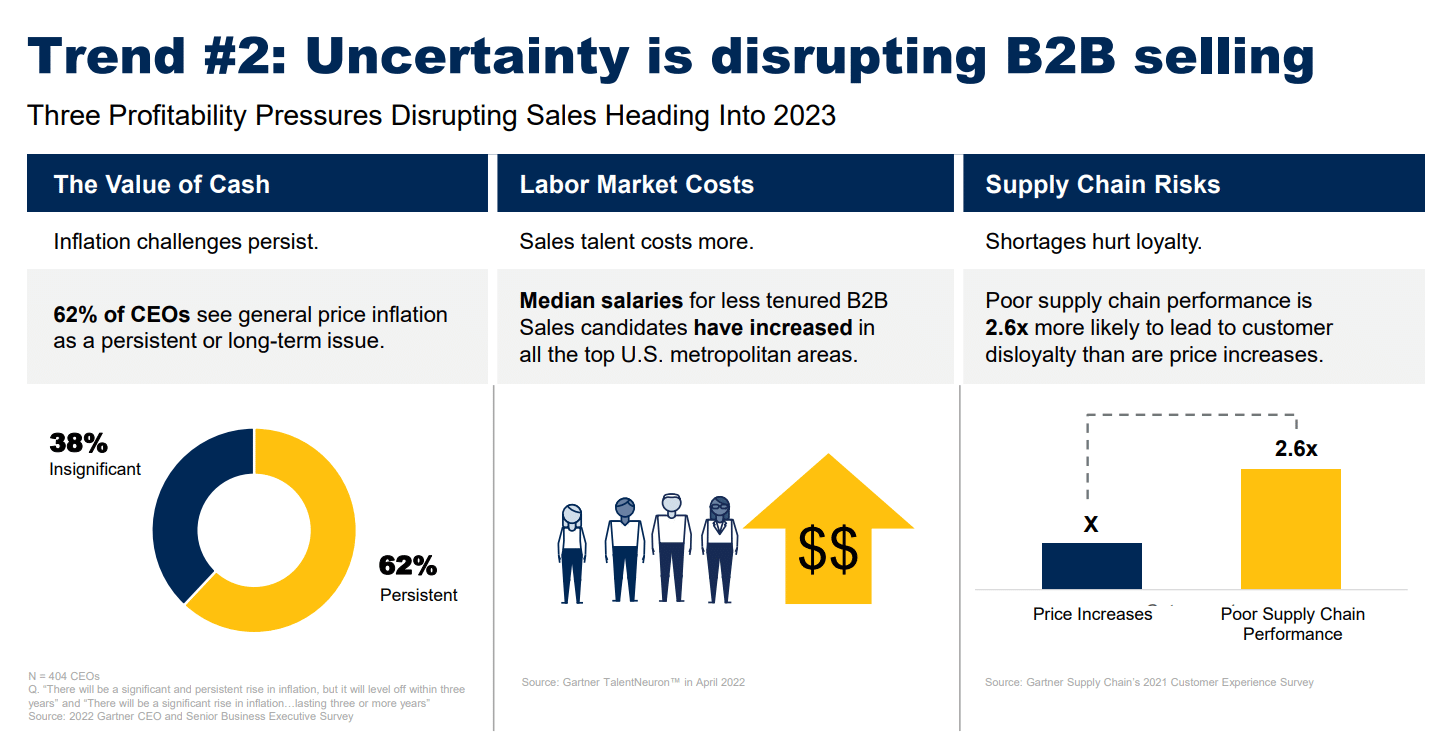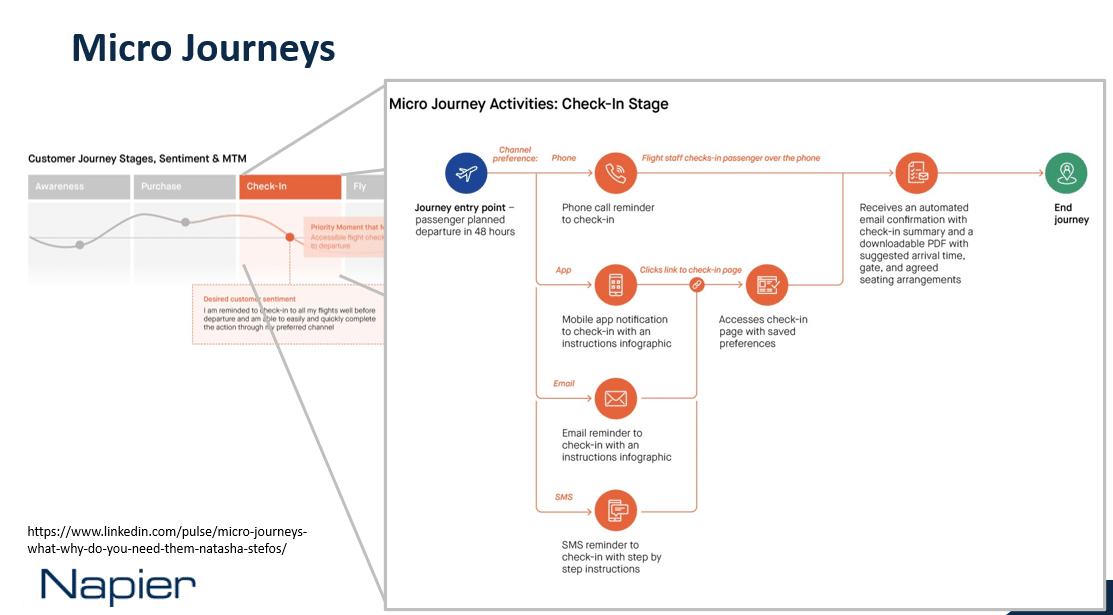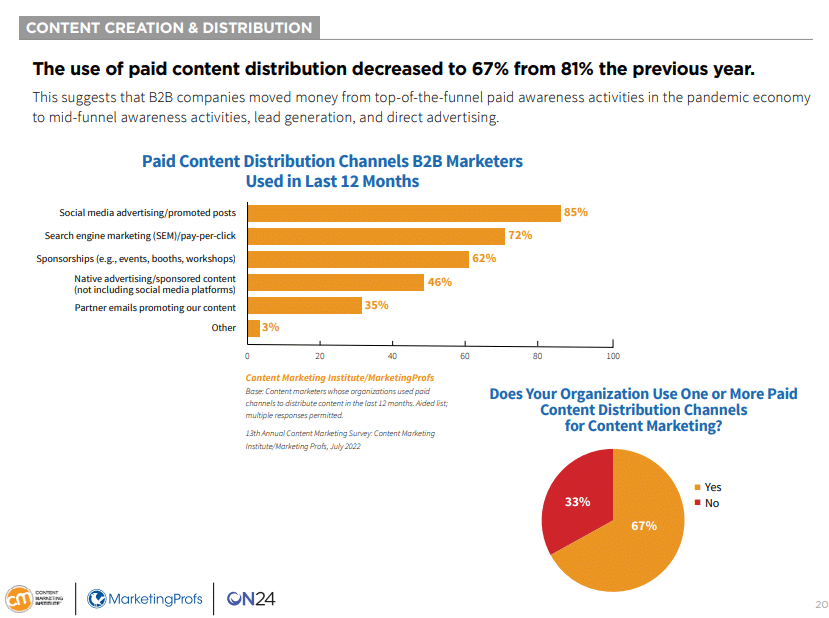Many clients ask us to give our take on the latest trends in marketing. We frequently put together presentations that analyse what has happened and make predictions about the way marketing will change in the future. This blog post is a summary of one of those recent presentations.
What Happened in 2022 – The Starting Point for Marketing
It’s always important to know where you are starting from, and 2022 proved to be an interesting year for marketing. A lot of the change was driven by the fact we began to exit the crisis caused by the COVID pandemic, although other crises were also available during the year. The return to more normal working after coronavirus, however, made it clear that things would never be quite the same again.
Customers Interact More with Marketing, Less with Sales
Perhaps the biggest change was the increase in the time B2B suppliers spend on self-directed research rather than talking to salespeople. Now, this is by no means a new trend: let’s face it there was a far bigger impact when companies started putting product data on their websites and salespeople could no longer secure a face-to-face meeting by offering to bring a printed data book. But the rate of change accelerated during COVID and in many industries, it’s clear that buyers are not going back to pre-pandemic levels of interaction with sales.
I’ve heard many salespeople complain about how much harder their job is because customers don’t want to meet in person any more, and often are reluctant to have online meetings too. The result is that by spending more time researching themselves, customers are more reliant on marketing content and less on salespeople when making decisions.

Although this does mean that marketing is more important if you want to be successful, it doesn’t mean salespeople are now irrelevant. In fact, one of the things that sales teams can do is to work closely with marketing teams to develop content and campaigns that drive customers to take the step of engaging with a salesperson, as well as closing the sale which is still done in person for many industries (although the percentage of B2B sales made online without a human salesperson is increasing at a rapid rate).
Greater Focus on Customers
If we are honest, the B2B sector hasn’t always done a great job of considering customer experience (CX). The focus on experience has been something that has really mattered in the consumer space for some time, and we’re running behind. But in 2022 we saw many clients pay attention to really understanding their customers and devote resources to try to improve CX. This is something we believe will continue to develop over the coming years.
Move to Real Metrics
Napier has been banging on about the need to try to use business metrics, rather than the convenient but often misleading simple marketing metrics like CTR and impressions. We thought no one was listening, but apparently, they were because in 2022 many of our clients really started trying to dig into data to understand whether campaigns had achieved business goals.
This is great news: no one wants to run campaigns that have little or no impact on the audience. It’s also linked to the increase in people processing marketing and sales data for clients. In 2023 we’d expect to see more data-driven decisions in marketing that use real-world data rather than artificial metrics.
AI Content Generation
You’ve heard of ChatGPT, surely? And hopefully about similar tools for images like DALL-E. At the end of 2022 and beginning of 2023, it sometimes felt that generative AI was the only thing that mattered. We are now at the point where AI can create high-quality images and text that matches some of the content-farm generated SEO content. Although it’s difficult to know how quickly, these technologies are going to get better and better over the coming years. It is important, however, to not get carried away with the hype as they also have limitations – not least the fact that for image generation there is a real question over whether using copyrighted images in these tools is allowed (and they all have been trained on copyright images).

Four Categories of Marketing Trends for 2023
We believe there are four categories of trends for 2023:
- Megatrends: these trends are not things that just change in 2023, but are long-term trends that are becoming particularly powerful. Understanding megatrends is critical if you want to stay ahead of the marketing wave.
- Publishing and intermediaries: changes in publishing are hugely important to marketers, and 2023 will see some significant changes to both professional publishers and user-generated content.
- Tools and AI: we can’t get away from marketing technology. It has always been a key driver of what is possible, and in 2023 the emergence of usable AI will be a game-changer in some areas.
- Legislation: although we don’t expect any major changes on the scale of the introduction of GDPR, we do expect governments – and sometimes the companies themselves imposing restrictions – to continue to impact the way B2B marketing develops this year.
Marketing MegaTrends
The four megatrends we see are changes in the way people think about marketing or changes in the approach that customers take to brands. The megatrends are typically long-term changes and their impact is not restricted to 2023, although we expect them to be particularly powerful this year.
Credibility and Trust
The expectations that the public has of businesses are increasing, and your customers are a subset of the general public. In 2022 the Edelman Trust Barometer found that people around the world think that business is not doing enough to address societal problems. One specific example is that 52% think companies should do more on climate change.
Reputation – perhaps more than ever – is an important factor in the selection of B2B suppliers. Your customers know this and they are not going to do business with organisations that they feel might hurt the credibility they have and customers’ trust. We believe that 2023 is the year when brands have to address ESG and the way they do business to become a more attractive partner.
We expect an increase in brand-building tactics such as PR, where companies will want to tell their story in a way that reassures people and enhances their reputation. In fact, we expect that the companies that establish the best reputations will see a huge range of benefits, including better performance of middle-of-the-funnel and bottom-of-the-funnel campaigns such as email marketing.
Supporting the Self-Directed Customer Journey
In many cases we have realised that the phrase, “things will never be the same after COVID,” was wrong. Our personal lives are returning to normal, and we are happy to have close contact with friends and strangers at places from bars to concerts. When it comes to purchasing B2B products, however, it’s frightening how much things have changed and how quickly the “new normal” became “normal”.
Earlier in the post, the trend toward self-directed research was discussed. It’s nothing new, but the step-change we saw due to the pandemic seems irreversible. B2B buyers are spending less time talking with salespeople and more time interacting with marketing content when they do desk research. The importance of understanding this change is huge: companies need to be producing more marketing content, and some of this content should be addressing buyer needs at the bottom of the funnel that previously was the domain of sales. The most successful companies in the coming years will reduce the size of their salesforces and move money to marketing. Hoping that things will go back to the old way, where personal selling was important is a route to B2B disaster.
High-Quality Content Marketing Really Matters in 2023
A lot of the noise about content marketing has been around SEO: generating often low-quality content to target specific keywords. The value of this has always been somewhat questionable, and increasingly it looks like companies will turn to AI for this work. With so few AI models available – let’s face it today the GPT3 model that underpins ChatGPT is also behind pretty much every other AI marketing and content generation tool – organisations are going to produce content that is almost totally undifferentiated. Chasing the long tail with low-quality content just won’t work because anyone can do it with AI.
High-quality content really matters. Let’s be honest, a small percentage of high-quality content really matters. Yes, even with the time and effort we put into the content we generate there is definitely an 80/20 (or maybe a 95/5) rule that means a relatively small number of best-performing content pieces dominate the results achieved. In fact, research by ahrefs shows that 90.63% of content online gets no traffic from Google.
Smart companies realise this. They know that they need to generate lots of high-quality content to find the gems, but when they do find the “golden” content piece, they will double-down on it. They’ll produce different versions and formats. If it’s a white paper, they will make a video, or a podcast, or an infographic, or an eBook, or… well you get the idea. We think that the most successful brands in 2023 will be those that admit that some of their content is OK, but a small percentage is magic and they invest a lot of time and effort in spreading that magic content through as many channels and formats as possible.
Microjourneys will Dominate Customer Journey Conversations
Unbelievably the concept of customer journeys is only just over 30 years old. We’ve moved a long way from simple funnel models, but the reality is that many organisations are completely unrealistic in their view of the customer journey. All too often we see brands with complex sales processes try to create a five-email nurture sequence to move a prospect through the entire customer journey. With 74.6% of B2B sales taking at least four months (according to CSO Insights), and many much longer, trying to have one campaign for the whole customer journey is just not effective.

Driven by the need to show results, organisations will realise that the best way to think of the customer journey is in segments, or microjourneys. Campaigns might not be able to move someone all the way along a customer journey, but they can be incredibly effective in moving prospects a couple of steps forward. This is particularly true of marketing automation. By building campaigns around microjourneys and then linking the campaigns together, the leading B2B companies will create a powerful but manageable marketing machine.
Publishers and Influencers in 2023
We’ve grouped together publishers and influencers because it is so hard to tell them apart today, other than by looking at the business model. This is particularly true of B2B, where many of the leading influencers online are also editors working for the old-school publishers.
B2B Trade Media Battles on
You’ve got to feel sorry for B2B publishers. Only 25 years ago they simply needed to send out paper magazines. The readers wanted those printed titles because there were few alternative channels to get the information they needed to do their jobs. Marketers wanted to advertise because there were no other channels that had such cost-effective reach and great engagement.
And then the internet changed everything.
Fortunately for publishers, they still provide a service of aggregating news, technical information and new product launches that are needed by readers. The big tech services like Google and LinkedIn aren’t quite there yet and don’t have the same level of product. So B2B publishers will continue to struggle on.
But there is a real concern for the long term. We reviewed online advertising pricing for leading electronics trade media over the last five years. Most prices remained unchanged. Some had even fallen. With traffic to trade media roughly flat over that period, the revenue from display advertising is clearly falling in real terms: and that’s before you consider things like the use of ad blockers. So although they will struggle on, it’s not getting any easier for trade media to succeed (but perhaps with the real-term fall in costs they are becoming a more compelling channel).
Trade Publications Need to Get into Video
Perhaps an unsurprising prediction, but it’s worth saying that trade publications will need to increase their video content in 2023. Many have been slow to adopt video, but the expectations of readers is driven by what they see in their personal lives. This also presents a huge opportunity for brands to help publishers by generating video content.
One argument we often hear is that video is for young people. Maybe younger people are even more engaged with video than an older demographic, but even if this is the case it doesn’t mean an audience of business leaders doesn’t want video. In fact, research by Forbes showed that 60% of executives would rather watch a video than read text: a clear indication that you can’t use the youth excuse to avoid creating video content.
B2B Influencers in 2023
B2B is different from B2C, particularly when it comes to the impact of influencers. More importantly, different B2B markets have very different influencer landscapes. In some – for example marketing – you have mega-influencers like Seth Godin, Rand Fishkin and Neil Patel. IT security is another market where influencers can have large followings and drive the way the industry thinks. In others, such as electronics engineering, the larger influencers have modest followings and most are journalists or employed by suppliers.
In both B2B and B2C, however, micro-influencers and non-influencers, generally defined by having 1000 to 50000 and 100 to 5000 followers respectively, are extremely important. These following numbers are really consumer numbers and with content that is at the low end of these bands the influencer they exert is important.
Even in electronics, where engineers are not renowned for being social animals, nano-influencers and micro-influencers are emerging. We think that the future for social media in many B2B markets will be driven by these influencers with much more focussed audiences. The good news is that in consumer sectors, followers are more engaged with micro-influencers having 60% greater engagement rate than macro-influencers.
Paid Social Cements its Position in the 2023 B2B Marketing Mix
If we are honest, we’re hoping that you are wondering why we don’t see paid social as already part of the B2B marketing mix, but a surprising number of companies are only just beginning to benefit from paid social campaigns. The Content Marketing Institute found that 17% of B2B brands are not using social media ads or promoted posts.

LinkedIn is the obvious go-to platform for many due to the ability to target by demographics and firmographics, but we’ve also seen very effective campaigns on mainstream platforms from Facebook to TikTok. In particular, they can deliver very cost-effective retargeting campaigns, although you need to deliver content that is appropriate to the platform: to quote one insightful ex-client, “People go to Facebook to waste their time and brands should respect their wishes.”
AI and Tools
At the end of 2022, ChatGPT sent the world into a spin. Tools have been transforming marketing over recent years: 25 years ago many companies were not sending any marketing emails and today enterprises are paying $1M or more for a marketing automation platform to do this. AI is clearly going to have a massive impact on the features and capabilities of tools, almost certainly moving some marketing spend from people to technology.
Although we’re heavily involved in trialling and using new tools, it’s not clear that trailblazing is always the right approach. Being a “fast follower” is often a better strategy. Although some people are outsourcing work from writing Google Ads to creating LinkedIn posts to ChatGPT, the resultant quality is often not fabulous. Our advice is to test, test, test.
For example, we’ve used AI-generated content on our website but are still also writing content manually (this post is 100% human-generated in case you were wondering). Currently, the AI-generated content is doing OK, but there is a clear difference: the time readers spend on a computer-generated page is shorter than those written by people. The AI-generated content will improve, so in the near term the machines are not yet ready to take over and our experiments mean we will know exactly when we need to switch to synthetic writers.
Better Tools Drive more Focus on Strategy
Many marketing teams have been pressured to do more in less time, which can often result in strategy not getting the attention it deserves. Marketers are so focussed on creating and sending emails to the various divisions competing for attention that they don’t have enough time to think at a higher level.
We believe that as tools become better, the marketing teams will get the time they need to develop effective communication and marketing strategies. This is really important: we think that the quality and effectiveness of campaigns will increase because they are underpinned by better strategic thinking. So even if your new tool just saves time and doesn’t really improve quality, you should start seeing your results improve, provided that you use the time you save to build the foundation for better campaigns.
2023 will see More Channels per Campaign
The improvement in marketing technology will also drive an increase in the number of channels per campaign. In B2B, particularly for smaller campaigns (and many B2B campaigns are small), often only a small number of channels are used. This is not always a good idea: reaching the audience through multiple channels almost always makes campaigns more effective.
The good news is that not only will marketing technology free up time to allow teams to run multi-channel promotions, but the tools themselves will also add functionality that enables them to do a lot of the heavy lifting that’s needed to repurpose from one channel to another. Thinking multi-channel will become the norm, even for the smallest campaigns.
Personalisation Gets Real in 2023
Simply putting the recipient’s name at the start of an email isn’t really personalisation. Your prospects will expect relevant information that is tailored to their role, company and challenges. We know how effective personalisation can be: Everguage found that 86% of marketers got a measurable lift in business results when they personalised their campaigns.
The good news is that everything is coming together to allow greater personalisation. We collect more data about our contacts, prospects and customers than ever before. Marketing technology is providing new capabilities to make personalisation even easier. And tools will free up time to allow teams to build strategies around personalisation and implement them across campaigns.
We believe that the move to more personalisation will drive the leading marketing teams to invest even more in targeting their materials to the audience, and that those that lag behind will see the performance of generic campaigns fall. A part of this will be even more focus on ABM, with greater even greater attention paid to personalising content for the most important companies.
Marketing Legislation and Rules Become More Challenging
Although GDPR was perhaps the most challenging law for marketers in recent years, we will continue to see legislation affect the work we do. There could be major challenges around the legitimacy of AI-generated content with cases already making their way through the legal process to determine if software really can take a copyrighted picture and use it to make another image, and similar cases around the use of text are likely to follow. We also see companies effectively making the rules: the delayed but inevitable elimination of the third-party cookie is a good example.
Fear of Legislation Drives Focus on Owning Data
We believe that smart companies will move to increase the amount of first-party data that they own, primarily because they worry that other data sources will become harder and harder to use. This could be counter intuitive as owning data also presents compliance challenges, but in the long term it seems clear that the availability of third-party data will diminish.
We might see opportunities for publishers whose second-party data is not under attack in the same way that Google or Facebook are being challenged. But it is really hard for publishers to gather data and obtain consent, so we expect brands to decide they have to invest in first-party data and spend the time it takes to navigate the issues around following the rules and regulations.
Brands will have to work hard to grow their databases: the ease of opting out and the pressure on inboxes make any contact vulnerable to opting-out. Many contacts might opt-in for a while, then opt-out, only to opt-in later provided that the brand is running outbound campaigns that capture their attention at the right time. A good strategy and a clear value proposition are going to be crucial to maximise both contact acquisition and retention in 2023.
Conclusion: A Challenging 2023 for B2B Marketing
We’d love to know what you think about our predictions and whether you have any of your own. In 2023 we believe that automation and tools will help free up time, but to take advantage of new technology marketers must keep up-to-date. We also think that many brands will level-up their marketing, whether that is through better personalisation, more thoughtful strategy or simply building their knowledge through data. The landscape will be more challenging and you’ll have to work harder to cut through the noise.
We also think that 2023 is going to be exciting, particularly as our customers and influencers rely less on interactions with sales and consume more marketing content when making decisions. Communications and marketing have never been so important to B2B companies as they are today, and we’re looking forward to the challenge and making the biggest possible impact on our client’s business goals.
Author
-
In 2001 Mike acquired Napier with Suzy Kenyon. Since that time he has directed major PR and marketing programmes for a wide range of technology clients. He is actively involved in developing the PR and marketing industries, and is Chair of the PRCA B2B Group, and lectures in PR at Southampton Solent University. Mike offers a unique blend of technical and marketing expertise, and was awarded a Masters Degree in Electronic and Electrical Engineering from the University of Surrey and an MBA from Kingston University.
View all posts

